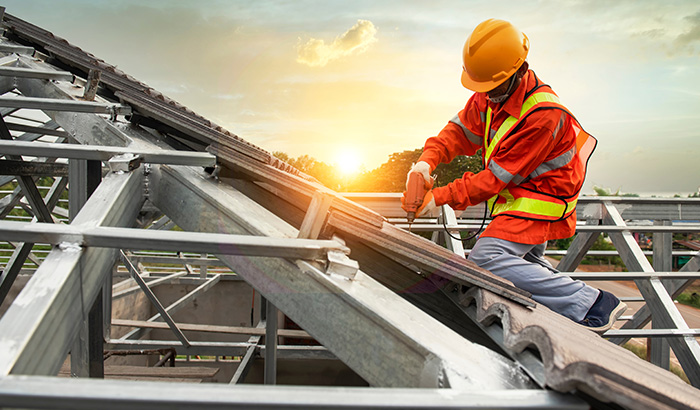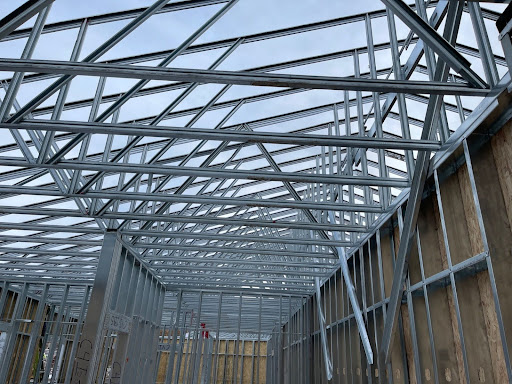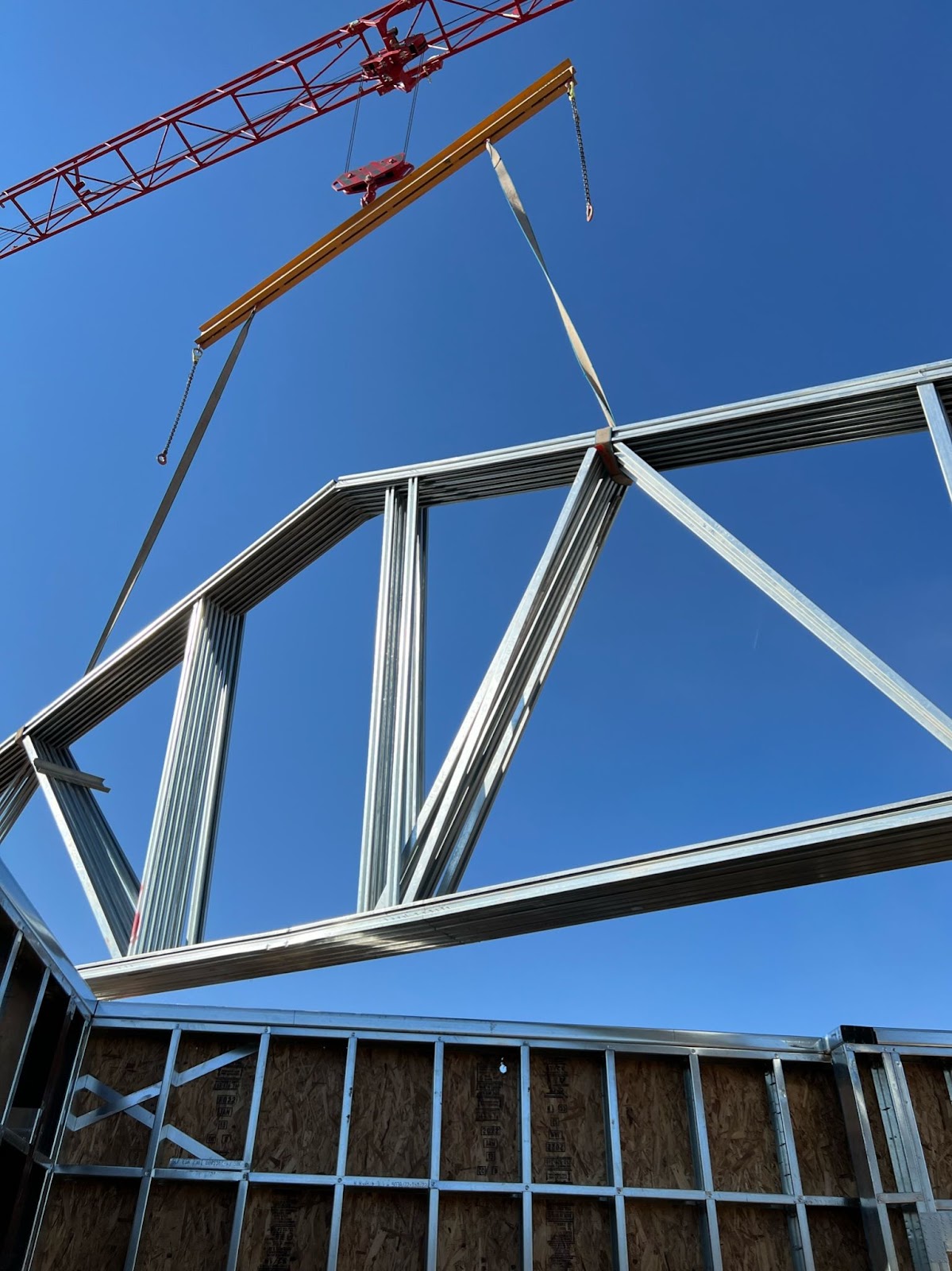Roof trusses are an often overlooked yet vital component in modern building construction. These masterpieces of engineering are usually comprised of timber or metal frameworks and support roofs of all sizes. They are the epitome of strength, efficiency, and design versatility.
This guide takes a deep dive into the fascinating world of roof trusses. We will explore a range of truss types, each boasting unique features and designed for specific architectural styles and requirements. Additionally, for those embarking on a roofing or renovation project, we provide practical installation tips to make your experience with roof trusses smooth and efficient.
From experienced builders and aspiring architects to curious homeowners, this information empowers you with the knowledge and confidence to make well-informed decisions about roof trusses.
Understanding roof trusses
At its core, a roof truss is a structural framework designed to support the roof of a building. It’s like a bridge that spans the top of your home, holding up the roof and ensuring everything stays in place.
Roof trusses have an intriguing history, tracing back to ancient times. Initially, they were simple structures made from timber, used in various forms across different cultures. The evolution of trusses mirrors the advancement of engineering and architectural knowledge. From the heavy, ornate trusses of medieval cathedrals to the sleek, efficient designs in modern architecture, these structures have continually adapted to meet changing needs and technologies.
Today, trusses are at the forefront of architectural and engineering innovation, blending functionality with aesthetic appeal. Engineers and architects design modern trusses using advanced materials and techniques, allowing for greater spans and more intricate designs than ever before.
In contemporary architecture, roof trusses are more than hidden structural elements; they often become focal points of design. Architects now use trusses to create stunning visual effects, with exposed truss work adding character and style to both the interiors and exteriors of buildings.
With the advent of computer-aided design (CAD) and manufacturing, the precision and possibilities in truss design have expanded exponentially. This technology enables the creation of trusses that are stronger, more efficient, and more aligned with the unique aesthetic visions of each project.
Today’s roof trusses are a testament to the synergy between historical craftsmanship and modern technology, playing a pivotal role in shaping the skylines of the future.
The basic components of a roof truss
Top chords: These are the upper members of the truss, often sloping downwards from the peak. They bear the majority of the tension forces in the truss.
Bottom chord: This is the bottom part of the truss, usually horizontal. It carries the tension forces and acts as a tie between the truss’s legs, preventing them from splaying out.
Webbing: These are the internal beams that connect the top and bottom chords, forming triangular patterns. The webbing distributes the weight and stress across the truss, adding strength and stability.
Gusset plates: These are the connectors — often made of steel or plywood — that join the various elements of the truss. These maintain the truss’s integrity under a range of load conditions.
With this knowledge, you’re well on your way to grasping the more intricate aspects of roof trusses, which we will explore further in this guide. Whether planning a construction project or simply curious about the structures above you, knowing about roof trusses adds an exciting dimension to your architectural knowledge.
Types of roof trusses
There are many types of roof trusses, each unique in design and application. Understanding these options allows you to make informed decisions, whether building a new home, designing a commercial space, or appreciating the engineering marvels above your head.
Let’s explore some of the most common types:
Common truss
Known for its simple and efficient triangular shape, the common truss is a staple in residential construction. It consists of a horizontal bottom chord and sloping top chords, meeting at an apex with a web of internal braces. This design offers a balance of cost-effectiveness and strength, making it a popular choice for standard roof designs in homes and small buildings.
Flat roof truss
A flat roof truss is used in buildings to support a flat or nearly flat roof. Unlike traditional pitched or sloped trusses, flat roof trusses are designed to provide a horizontal roof structure. They comprise a series of parallel chords (the top and bottom segments of the truss) connected by webs (the internal braces), forming a flat or slightly sloped surface to support the roof deck and any loads placed upon it.
Queen post truss
This truss has two vertical posts (queen posts), offering greater support and allowing for longer spans than the king post truss. Larger residential buildings or light commercial structures often use this type of truss. Designers and consumers alike appreciate the queen post truss for its aesthetic appeal, and designers often leave the truss exposed in interior designs for a classic, open-beam look.
Scissor truss
Unique for its intersecting sloping top chords, which create an elevated ceiling effect, the scissor truss is a favorite in buildings with vaulted ceilings. This design enhances the aesthetic of a space while providing ample room for insulation, making it a practical choice for energy-efficient buildings.
Other types of roof trusses
- Attic truss: Designed to create usable space within the truss, attic trusses are perfect for adding an extra room or storage area without altering the building’s footprint.
- Bowstring trusses: Arch-shaped trusses, often used in large, open buildings like warehouses or gymnasiums, provide large, clear spans.
- Dual pitch trusses: These trusses feature two different slopes on either side of the peak, offering an architectural twist commonly used for aesthetic purposes in custom-designed buildings.
Steel vs. wooden roof trusses
When deciding on roof trusses for a building project, the choice often boils down to two primary materials: wood and steel. While each has its merits, recent trends in the industry are showing a notable shift towards steel, particularly cold-formed steel trusses, in both residential and commercial construction in the U.S. and internationally.
Steel roof trusses are gaining ground, especially those formed from cold-formed steel. One of their most significant advantages is their non-combustible nature, which not only enhances safety but also leads to substantial savings — up to 75% — on builder’s insurance for the project owner or developer. Steel trusses are incredibly durable and ideal for large spans, making them well-suited for commercial or industrial buildings.
The increasing use of Cold-Formed Steel (CFS) trusses in residential construction marks a significant shift in building practices, driven largely by their exceptional resilience to various environmental challenges. These trusses are able to withstand extreme weather conditions such as heavy snow, high winds, and severe storms.
CFS trusses also present a defense against common issues that plague traditional building materials. Their resistance to pests, particularly termites and other wood-boring insects, is a significant advantage. This feature alone makes CFS trusses a more durable and long-lasting option compared to wood.
The fire-resistant nature of CFS trusses adds another layer of safety to residential constructions. Unlike wood, steel does not contribute to fire spread and has a much higher melting point. This makes CFS trusses a safer option in the event of a fire, which is a consideration that is important to homeowners and developers alike.
The practicality of steel trusses extends beyond their initial installation. Their lower maintenance requirements make them a long-term, cost-effective roofing solution. Precision in manufacturing ensures consistent quality and fit, adding to their reliability. While wooden trusses have traditionally dominated the construction landscape, the tide is turning in favor of steel trusses.
From flat roof to bowstring to CFS, each type of roof truss has its own characteristics and ideal use cases, offering a range of solutions to meet different architectural needs and preferences. Whether you’re looking to maximize space, achieve a specific look, or simply ensure structural integrity, there’s a truss design out there to fit your project.
Considerations before installation
Before installing roof trusses, it’s important to take a step back and consider a few critical aspects. This preparation helps guarantee that your project meets your expectations and adheres to safety standards.
First, let’s talk about assessing the roof load. Understanding the weights and stresses your truss will need to handle is crucial. This isn’t merely about the roof materials; consider environmental factors like heavy snowfall or strong winds.
Getting a clear picture of these elements will guide you in choosing a truss that’s up to the task. This is one area where accuracy can’t be compromised, as the safety and longevity of your structure depend on it.
Next, sizing and customization of your truss should be high on your agenda. This isn’t a one-size-fits-all situation. You need to consider the unique dimensions of your space, the pitch of the roof, and any specific architectural features like chimneys or skylights that could impact the truss design. Tailoring the truss to these specifics maximizes the truss’s efficiency and effectiveness.
Last but certainly not least is the adherence to local building codes. These regulations are there for good reason — to keep everyone safe.
It’s essential to familiarize yourself with the codes relevant to your area. They may vary, covering aspects from the strength of materials to fire safety measures. Compliance with these standards will protect you, as it’s not only a legal obligation but a commitment to the durability and safety of your building.
Considering these factors before starting your roof truss installation sets a solid foundation for your project, ensuring a smooth, safe, and successful build.
Maintenance of roof trusses
Keeping your roof trusses in great shape is an important part of home maintenance. After all, they’re the backbone of your roof’s structure.
Here’s how to keep an eye on them and ensure they stay in top condition.
First up, it’s a good idea to give your trusses a thorough check at least twice a year. Spring and fall are ideal times for this. When you’re inspecting, look out for any signs of damage to the truss, like cracks or warping, especially around the joints.
Maintenance-wise, the key is to keep things dry and well-ventilated up there. Moisture is the enemy of wooden trusses, so ensuring that your attic or roof space doesn’t become a damp haven is essential. This is another reason why builders more commonly use steel trusses today.
Be cautious about making any big changes, like adding heavy fixtures to your roof, without professional guidance. This could alter the load your trusses were designed to carry.
Now, when should you call in the professionals? If you spot significant structural changes like serious bending or cracking, it’s definitely time to get expert eyes on the situation. Also, after any extreme weather events like heavy snowfall or strong winds, having a professional assess your trusses for any damage is a smart move.
And, of course, if you’re planning any renovations that might affect your roof, a professional can advise you on how to proceed without compromising the integrity of your trusses.
Regularly checking and maintaining your roof trusses is like giving your home or business a health check. It ensures that your roof remains a safe, sturdy shelter for years to come. When in doubt, always err on the side of caution and consult a professional to take care of this part of your home.
Choose Salt Lake Prefab
Choosing a reliable partner for your roof truss project is as important as the design and materials you select. Salt Lake Prefab is the perfect partner for all your offsite construction and roofing needs. Our team specializes in designing and manufacturing top-quality roof trusses tailored to support a wide range of projects, from residential to industrial.
At Salt Lake Prefab, we pride ourselves on our precision and attention to detail, ensuring each truss meets the highest standards of strength and durability.
We also understand that in construction, timing is everything. That’s why we’re committed to efficient production and on-time delivery, helping your roofing project stay on schedule.
Call us at 385-557-6800 or contact Salt Lake Prefab online. Let’s build something great together!



